Holly Thompson's Blog, page 38
May 12, 2011
Ishinomaki Day 5
Following is Day 5 of my week in Tohoku volunteering with the NGO Peace Boat in the tsunami-devastated city of Ishinomaki, Miyagi Prefecture.
Other NGOs besides Peace Boat were evident in Ishinomaki, some working directly with or alongside Peace Boat.
 Second Harvest Japan
Second Harvest Japan
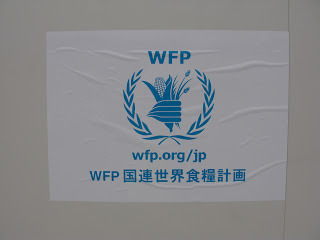 World Food Program
World Food Program
The morning routine was the same--breakfast, getting suited up, morning assembly, exercises, some speeches including words of grateful residents that brought tears to our eyes. Our team was assigned an 8:15 bus to Ai Plaza. At Ai Plaza we picked up our equipment from the piles.
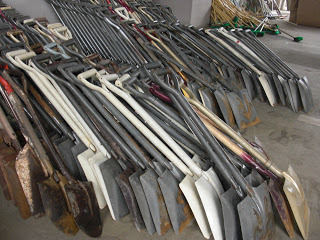 the all important shovels
the all important shovels
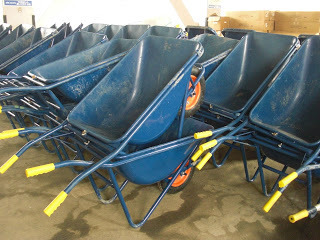 the wheelbarrows for lugging everything
the wheelbarrows for lugging everything
 all ready for another work dayWe were assigned to work with another team emptying the home of a woman now deceased. Family members were in the house hastily going through belongings, most of which were being discarded. We handed belongings out in a chain and heaped them onto the rubbish pile, dealt with broken glass and cleaned the sidewalks. The house was at a tilt due to the quake and tsunami and we were relieved when we were finished bringing all the belongings out.
all ready for another work dayWe were assigned to work with another team emptying the home of a woman now deceased. Family members were in the house hastily going through belongings, most of which were being discarded. We handed belongings out in a chain and heaped them onto the rubbish pile, dealt with broken glass and cleaned the sidewalks. The house was at a tilt due to the quake and tsunami and we were relieved when we were finished bringing all the belongings out.
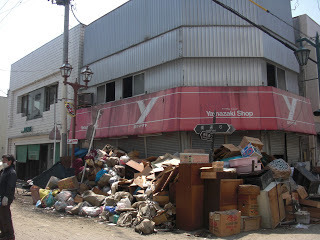 Across the street some shopkeepers worked all day laundering shop goods--T-shirts and bags. Next door another team of volunteers washed muddied tea shop dishes.
Across the street some shopkeepers worked all day laundering shop goods--T-shirts and bags. Next door another team of volunteers washed muddied tea shop dishes.
At lunch break back at Ai Plaza, there was a small vase of flowers thanking us volunteers.
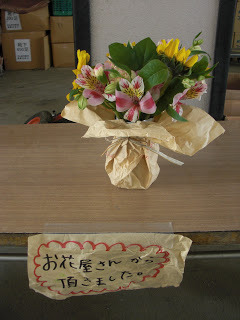 thanks from a flower shop to Peace Boat volunteers
thanks from a flower shop to Peace Boat volunteers
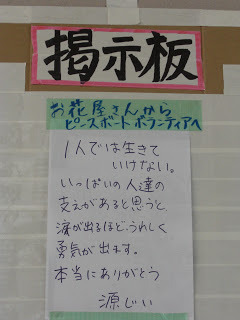 note from the flower shop--the support from you volunteers brings tears to our eyes and gives us courage.Those expressions of gratitude, as well as the opportunity to meet and work alongside the other volunteers and locals, were definitely highlights of the week.
note from the flower shop--the support from you volunteers brings tears to our eyes and gives us courage.Those expressions of gratitude, as well as the opportunity to meet and work alongside the other volunteers and locals, were definitely highlights of the week.
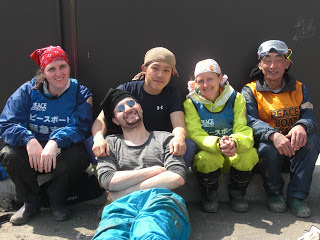 lunch break
lunch break
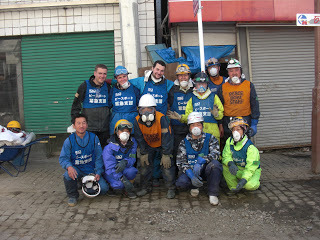 afternoon work breakOur day ended earlier than on previous days. We took the tools to the clean station and had them and ourselves power washed. For a change it was warm and sunny, and our suits dried fast.
afternoon work breakOur day ended earlier than on previous days. We took the tools to the clean station and had them and ourselves power washed. For a change it was warm and sunny, and our suits dried fast.
 araiba or clean stationWe walked back to Ai Plaza, and as always in Ishinomaki, moments of sadness...
araiba or clean stationWe walked back to Ai Plaza, and as always in Ishinomaki, moments of sadness...
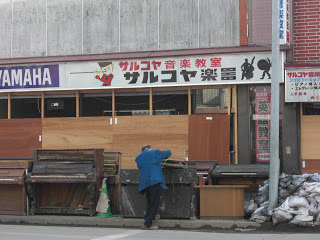 damaged pianos on the street
damaged pianos on the street
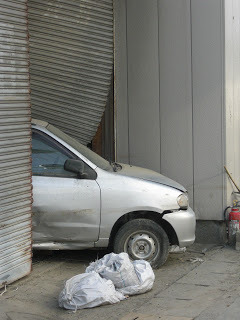 tsunami flood-deposited carwere followed by moments of hope and encouragement. At our central Ai Plaza base, two shamisen musicians were playing shovels to entertain the volunteers. One of our team members joined in.
tsunami flood-deposited carwere followed by moments of hope and encouragement. At our central Ai Plaza base, two shamisen musicians were playing shovels to entertain the volunteers. One of our team members joined in.
 Ai Plaza entertainment at the end of the daySome teams traveled back to the university by bus, others by bicycle, and still others were smooshed into cars.
Ai Plaza entertainment at the end of the daySome teams traveled back to the university by bus, others by bicycle, and still others were smooshed into cars.
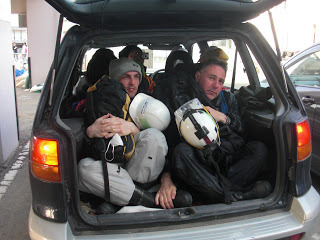 one mode of transport back to the university campsiteBack at camp in our individual tents, we changed out of our cleaning gear, body washed with the incredibly effective body wipes, then learned to our delight that two dinners were to be offered to volunteers that night--one by the usual food truck and another by volunteers from Nasu Shiobara Onsen. We couldn't resist the latter's offerings--pizza and hot soba, plus drinks, snacks and dessert. Dozens of volunteers just sat down in the parking lot and enjoyed this kindness.
one mode of transport back to the university campsiteBack at camp in our individual tents, we changed out of our cleaning gear, body washed with the incredibly effective body wipes, then learned to our delight that two dinners were to be offered to volunteers that night--one by the usual food truck and another by volunteers from Nasu Shiobara Onsen. We couldn't resist the latter's offerings--pizza and hot soba, plus drinks, snacks and dessert. Dozens of volunteers just sat down in the parking lot and enjoyed this kindness.
Tea and laughs and sharing of experiences followed at my tent, the largest of our team member's tents, then like every night as the air turned cold we all crashed early to be ready for the next day's work assignment.
Other NGOs besides Peace Boat were evident in Ishinomaki, some working directly with or alongside Peace Boat.
 Second Harvest Japan
Second Harvest Japan
 World Food Program
World Food ProgramThe morning routine was the same--breakfast, getting suited up, morning assembly, exercises, some speeches including words of grateful residents that brought tears to our eyes. Our team was assigned an 8:15 bus to Ai Plaza. At Ai Plaza we picked up our equipment from the piles.
 the all important shovels
the all important shovels
 the wheelbarrows for lugging everything
the wheelbarrows for lugging everything
 all ready for another work dayWe were assigned to work with another team emptying the home of a woman now deceased. Family members were in the house hastily going through belongings, most of which were being discarded. We handed belongings out in a chain and heaped them onto the rubbish pile, dealt with broken glass and cleaned the sidewalks. The house was at a tilt due to the quake and tsunami and we were relieved when we were finished bringing all the belongings out.
all ready for another work dayWe were assigned to work with another team emptying the home of a woman now deceased. Family members were in the house hastily going through belongings, most of which were being discarded. We handed belongings out in a chain and heaped them onto the rubbish pile, dealt with broken glass and cleaned the sidewalks. The house was at a tilt due to the quake and tsunami and we were relieved when we were finished bringing all the belongings out.  Across the street some shopkeepers worked all day laundering shop goods--T-shirts and bags. Next door another team of volunteers washed muddied tea shop dishes.
Across the street some shopkeepers worked all day laundering shop goods--T-shirts and bags. Next door another team of volunteers washed muddied tea shop dishes.At lunch break back at Ai Plaza, there was a small vase of flowers thanking us volunteers.
 thanks from a flower shop to Peace Boat volunteers
thanks from a flower shop to Peace Boat volunteers
 note from the flower shop--the support from you volunteers brings tears to our eyes and gives us courage.Those expressions of gratitude, as well as the opportunity to meet and work alongside the other volunteers and locals, were definitely highlights of the week.
note from the flower shop--the support from you volunteers brings tears to our eyes and gives us courage.Those expressions of gratitude, as well as the opportunity to meet and work alongside the other volunteers and locals, were definitely highlights of the week. lunch break
lunch break
 afternoon work breakOur day ended earlier than on previous days. We took the tools to the clean station and had them and ourselves power washed. For a change it was warm and sunny, and our suits dried fast.
afternoon work breakOur day ended earlier than on previous days. We took the tools to the clean station and had them and ourselves power washed. For a change it was warm and sunny, and our suits dried fast. araiba or clean stationWe walked back to Ai Plaza, and as always in Ishinomaki, moments of sadness...
araiba or clean stationWe walked back to Ai Plaza, and as always in Ishinomaki, moments of sadness... damaged pianos on the street
damaged pianos on the street
 tsunami flood-deposited carwere followed by moments of hope and encouragement. At our central Ai Plaza base, two shamisen musicians were playing shovels to entertain the volunteers. One of our team members joined in.
tsunami flood-deposited carwere followed by moments of hope and encouragement. At our central Ai Plaza base, two shamisen musicians were playing shovels to entertain the volunteers. One of our team members joined in. Ai Plaza entertainment at the end of the daySome teams traveled back to the university by bus, others by bicycle, and still others were smooshed into cars.
Ai Plaza entertainment at the end of the daySome teams traveled back to the university by bus, others by bicycle, and still others were smooshed into cars. one mode of transport back to the university campsiteBack at camp in our individual tents, we changed out of our cleaning gear, body washed with the incredibly effective body wipes, then learned to our delight that two dinners were to be offered to volunteers that night--one by the usual food truck and another by volunteers from Nasu Shiobara Onsen. We couldn't resist the latter's offerings--pizza and hot soba, plus drinks, snacks and dessert. Dozens of volunteers just sat down in the parking lot and enjoyed this kindness.
one mode of transport back to the university campsiteBack at camp in our individual tents, we changed out of our cleaning gear, body washed with the incredibly effective body wipes, then learned to our delight that two dinners were to be offered to volunteers that night--one by the usual food truck and another by volunteers from Nasu Shiobara Onsen. We couldn't resist the latter's offerings--pizza and hot soba, plus drinks, snacks and dessert. Dozens of volunteers just sat down in the parking lot and enjoyed this kindness.Tea and laughs and sharing of experiences followed at my tent, the largest of our team member's tents, then like every night as the air turned cold we all crashed early to be ready for the next day's work assignment.
Published on May 12, 2011 06:34
May 11, 2011
Ishinomaki Day 4
Following is Day 3 of my week in Tohoku volunteering with the NGO Peace Boat in the tsunami-devastated city of Ishinomaki, Miyagi Prefecture.
The night was cold but still, and without the wind I slept until 6 a.m. then joined our team around a cook stove for breakfast. The meeting of all volunteers was held at 7:30 as usual.
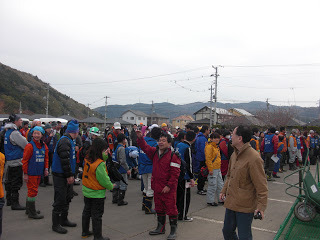 assembling for the morning meetingNext was rajio taiso as usual.
assembling for the morning meetingNext was rajio taiso as usual.
 rajio taiso exercisesThen our team, plus four other teams, boarded a bus to take us back to the Ibarazu district for our second day of fish detail--picking up fish from the fish market that had been deposited throughout the area.
rajio taiso exercisesThen our team, plus four other teams, boarded a bus to take us back to the Ibarazu district for our second day of fish detail--picking up fish from the fish market that had been deposited throughout the area.
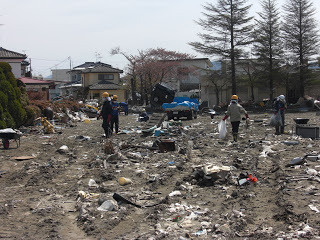 the first parking lot for picking up fisThe large, more dried out fish were the easiest.
the first parking lot for picking up fisThe large, more dried out fish were the easiest.
 me with a fish worth a fortune rotting awayThe 20 kilogram sacks of putrid rotting fish were the toughest--it was a rare triumph to find bags that hadn't burst open and could be taken away just as is.
me with a fish worth a fortune rotting awayThe 20 kilogram sacks of putrid rotting fish were the toughest--it was a rare triumph to find bags that hadn't burst open and could be taken away just as is.
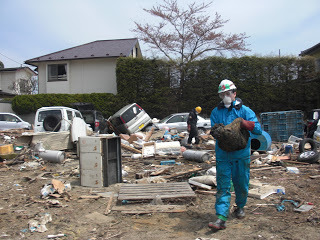 teammate hefting a 20 kg bag of fishWithout the wind the day grew hot. The stench from the fetid fish was overpowering. At one point I had to carefully remove gloves, goggles, mask, helmet, to shed the too many layers under my rain suit. We were all soon bordering on dehydration, and lunch was a welcome break. We had not been able to hose off so we removed gloves, washed hands with alcohol wipes and sat with our legs extended and our smelly booted feet as far away from our noses as possible.
teammate hefting a 20 kg bag of fishWithout the wind the day grew hot. The stench from the fetid fish was overpowering. At one point I had to carefully remove gloves, goggles, mask, helmet, to shed the too many layers under my rain suit. We were all soon bordering on dehydration, and lunch was a welcome break. We had not been able to hose off so we removed gloves, washed hands with alcohol wipes and sat with our legs extended and our smelly booted feet as far away from our noses as possible.
In the afternoon we worked in an adjacent parking lot where it seemed that everything had come to rest.
 belongings all tumbled together
belongings all tumbled together
 picking up fish from among the debrisI worked with one of the local guides as he hooked the larger fish and loaded them into my bag. I also covered the ground picking up fish with my gloved (2 layers) hands. The work was tough, and we all grunted and groaned and gagged our way through the process. I was repulsed but truly very glad to be helping the people of this district coping with not only the trauma and challenges of major tsunami damage but also a cruel inundation of decomposing fish.
picking up fish from among the debrisI worked with one of the local guides as he hooked the larger fish and loaded them into my bag. I also covered the ground picking up fish with my gloved (2 layers) hands. The work was tough, and we all grunted and groaned and gagged our way through the process. I was repulsed but truly very glad to be helping the people of this district coping with not only the trauma and challenges of major tsunami damage but also a cruel inundation of decomposing fish.
Midway through the afternoon, after another two tons worth of fish bags had been loaded onto the truck, leaders called out for volunteers to ride in the truck bed to wherever the bags would be heaped. I raised my hand and leapt onto the truck bed, atop the oozing bags of fish with four other volunteers. We rode a kilometer or two toward the sea, through ever more tsunami damaged areas. We stopped in the parking lot of a park and heaved the bags of fish onto the pile.
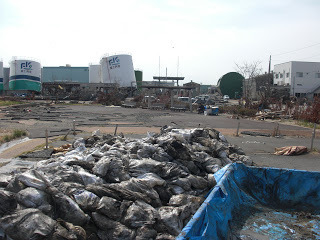 the heap of bags of fish, to be taken out to sea; in the distance a tilted gas tank and another tank on its side
the heap of bags of fish, to be taken out to sea; in the distance a tilted gas tank and another tank on its side
Back at the parking lot, exhausted, I stepped off the truck bed, and the driver popped a hard candy into my mouth...perfect.
In the afternoon we were careful to take water breaks in the hot sun. Back at the hospital base, we scrubbed our clothes before the power wash to save time and water.
 washing off our gearOur local guides stayed with us until we left the district, and they patiently posed with the various Peace Boat teams.
washing off our gearOur local guides stayed with us until we left the district, and they patiently posed with the various Peace Boat teams.
 our team with local Ibarazu guidesA bus took us back to the university campsite, and the truck driver from Osaka with his high energy buddies was waiting for us outside his tent with hot coffee and an enormous bag of chips that we devoured. Then they offered the ultimate--warm water for a shampoo. A teammate and I jumped at the chance. One of the contractors held up the tank of water over a drain while we each shampooed our long hair. Not a shower, but to have washed that fish smell out of our hair was a major coup. I felt brand new.
our team with local Ibarazu guidesA bus took us back to the university campsite, and the truck driver from Osaka with his high energy buddies was waiting for us outside his tent with hot coffee and an enormous bag of chips that we devoured. Then they offered the ultimate--warm water for a shampoo. A teammate and I jumped at the chance. One of the contractors held up the tank of water over a drain while we each shampooed our long hair. Not a shower, but to have washed that fish smell out of our hair was a major coup. I felt brand new.
 with wet shampooed hair and very happy thanks to our Osaka heroesDinner for our team was noodles and curry from retort pouches cooked on a stove in the vestibule of my tent since the rains had returned. Thankfully the winds did not return. It was an early night for our fish-exhausted team. In three days (of which our team had worked two), Peace Boat volunteers had removed 18 tons of fish from Ibarazu. In Japanese, here is an account of the fish effort and a video from Niconico News showing some of our team members in action.
with wet shampooed hair and very happy thanks to our Osaka heroesDinner for our team was noodles and curry from retort pouches cooked on a stove in the vestibule of my tent since the rains had returned. Thankfully the winds did not return. It was an early night for our fish-exhausted team. In three days (of which our team had worked two), Peace Boat volunteers had removed 18 tons of fish from Ibarazu. In Japanese, here is an account of the fish effort and a video from Niconico News showing some of our team members in action.
The night was cold but still, and without the wind I slept until 6 a.m. then joined our team around a cook stove for breakfast. The meeting of all volunteers was held at 7:30 as usual.
 assembling for the morning meetingNext was rajio taiso as usual.
assembling for the morning meetingNext was rajio taiso as usual. rajio taiso exercisesThen our team, plus four other teams, boarded a bus to take us back to the Ibarazu district for our second day of fish detail--picking up fish from the fish market that had been deposited throughout the area.
rajio taiso exercisesThen our team, plus four other teams, boarded a bus to take us back to the Ibarazu district for our second day of fish detail--picking up fish from the fish market that had been deposited throughout the area. the first parking lot for picking up fisThe large, more dried out fish were the easiest.
the first parking lot for picking up fisThe large, more dried out fish were the easiest. me with a fish worth a fortune rotting awayThe 20 kilogram sacks of putrid rotting fish were the toughest--it was a rare triumph to find bags that hadn't burst open and could be taken away just as is.
me with a fish worth a fortune rotting awayThe 20 kilogram sacks of putrid rotting fish were the toughest--it was a rare triumph to find bags that hadn't burst open and could be taken away just as is.  teammate hefting a 20 kg bag of fishWithout the wind the day grew hot. The stench from the fetid fish was overpowering. At one point I had to carefully remove gloves, goggles, mask, helmet, to shed the too many layers under my rain suit. We were all soon bordering on dehydration, and lunch was a welcome break. We had not been able to hose off so we removed gloves, washed hands with alcohol wipes and sat with our legs extended and our smelly booted feet as far away from our noses as possible.
teammate hefting a 20 kg bag of fishWithout the wind the day grew hot. The stench from the fetid fish was overpowering. At one point I had to carefully remove gloves, goggles, mask, helmet, to shed the too many layers under my rain suit. We were all soon bordering on dehydration, and lunch was a welcome break. We had not been able to hose off so we removed gloves, washed hands with alcohol wipes and sat with our legs extended and our smelly booted feet as far away from our noses as possible.In the afternoon we worked in an adjacent parking lot where it seemed that everything had come to rest.
 belongings all tumbled together
belongings all tumbled together
 picking up fish from among the debrisI worked with one of the local guides as he hooked the larger fish and loaded them into my bag. I also covered the ground picking up fish with my gloved (2 layers) hands. The work was tough, and we all grunted and groaned and gagged our way through the process. I was repulsed but truly very glad to be helping the people of this district coping with not only the trauma and challenges of major tsunami damage but also a cruel inundation of decomposing fish.
picking up fish from among the debrisI worked with one of the local guides as he hooked the larger fish and loaded them into my bag. I also covered the ground picking up fish with my gloved (2 layers) hands. The work was tough, and we all grunted and groaned and gagged our way through the process. I was repulsed but truly very glad to be helping the people of this district coping with not only the trauma and challenges of major tsunami damage but also a cruel inundation of decomposing fish.Midway through the afternoon, after another two tons worth of fish bags had been loaded onto the truck, leaders called out for volunteers to ride in the truck bed to wherever the bags would be heaped. I raised my hand and leapt onto the truck bed, atop the oozing bags of fish with four other volunteers. We rode a kilometer or two toward the sea, through ever more tsunami damaged areas. We stopped in the parking lot of a park and heaved the bags of fish onto the pile.
 the heap of bags of fish, to be taken out to sea; in the distance a tilted gas tank and another tank on its side
the heap of bags of fish, to be taken out to sea; in the distance a tilted gas tank and another tank on its sideBack at the parking lot, exhausted, I stepped off the truck bed, and the driver popped a hard candy into my mouth...perfect.
In the afternoon we were careful to take water breaks in the hot sun. Back at the hospital base, we scrubbed our clothes before the power wash to save time and water.
 washing off our gearOur local guides stayed with us until we left the district, and they patiently posed with the various Peace Boat teams.
washing off our gearOur local guides stayed with us until we left the district, and they patiently posed with the various Peace Boat teams. our team with local Ibarazu guidesA bus took us back to the university campsite, and the truck driver from Osaka with his high energy buddies was waiting for us outside his tent with hot coffee and an enormous bag of chips that we devoured. Then they offered the ultimate--warm water for a shampoo. A teammate and I jumped at the chance. One of the contractors held up the tank of water over a drain while we each shampooed our long hair. Not a shower, but to have washed that fish smell out of our hair was a major coup. I felt brand new.
our team with local Ibarazu guidesA bus took us back to the university campsite, and the truck driver from Osaka with his high energy buddies was waiting for us outside his tent with hot coffee and an enormous bag of chips that we devoured. Then they offered the ultimate--warm water for a shampoo. A teammate and I jumped at the chance. One of the contractors held up the tank of water over a drain while we each shampooed our long hair. Not a shower, but to have washed that fish smell out of our hair was a major coup. I felt brand new. with wet shampooed hair and very happy thanks to our Osaka heroesDinner for our team was noodles and curry from retort pouches cooked on a stove in the vestibule of my tent since the rains had returned. Thankfully the winds did not return. It was an early night for our fish-exhausted team. In three days (of which our team had worked two), Peace Boat volunteers had removed 18 tons of fish from Ibarazu. In Japanese, here is an account of the fish effort and a video from Niconico News showing some of our team members in action.
with wet shampooed hair and very happy thanks to our Osaka heroesDinner for our team was noodles and curry from retort pouches cooked on a stove in the vestibule of my tent since the rains had returned. Thankfully the winds did not return. It was an early night for our fish-exhausted team. In three days (of which our team had worked two), Peace Boat volunteers had removed 18 tons of fish from Ibarazu. In Japanese, here is an account of the fish effort and a video from Niconico News showing some of our team members in action.
Published on May 11, 2011 06:17
May 10, 2011
Ishinomaki Day 3
Following is Day 3 of my week in Tohoku volunteering with the NGO Peace Boat in the tsunami-devastated city of Ishinomaki, Miyagi Prefecture.
The rain stopped but a strong wind came up around 3 a.m. The tent leaned and flapped in the powerful gusts. I stepped outside to stomp on all my tent stakes and hoped they would hold. Then I waited for dawn; there was no chance of any more sleep in that wind.
Morning meeting was at 7:30 as usual, followed by exercises and explanations of team assignments.
Our team, like many teams that day, was assigned to help pick up fish in the district of Ibarazu; about 60 volunteers were bused to Ibarazu where the tsunami had plowed through a major fish market and deposited 170,000 tons of fish of all varieties among the houses, on the roads, in and beneath the mangled cars, and in the trees. Our task was to help pick up and bag the stinking, rotting fish.
At our base, a small hospital, we were divided into groups of two or three teams, and with local guides we walked about the town, stopping to bag fish wherever the biggest deposits were and to heave the oozing bags into a truck bed.
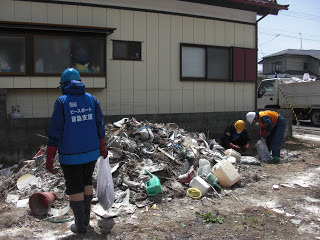 fishing...note the truck already heaped with bags of rotting fishOur first task was the worst--sorting through a reeking pile of fish and debris just outside a home to find the fish and even to rebag rotting fish that had been improperly bagged with debris.
fishing...note the truck already heaped with bags of rotting fishOur first task was the worst--sorting through a reeking pile of fish and debris just outside a home to find the fish and even to rebag rotting fish that had been improperly bagged with debris.
We spoke with our guide as we walked about the district; he had spent a month in an evacuation center then had moved back, eager to be home. The entire first story of his lovely Japanese-style house was ruined and now under reconstruction. He somehow had running water, so we were able to hose off some of the fish goo before our lunch break.
 our base at the hospital
our base at the hospital
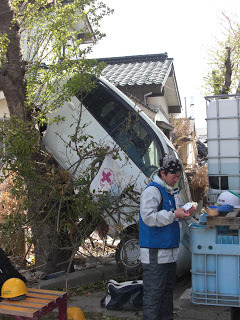 just outside the hospital's entranceIn the afternoon we worked in a parking lot by the hospital; the lot was covered with fish and tsunami sludge embedded with fish.
just outside the hospital's entranceIn the afternoon we worked in a parking lot by the hospital; the lot was covered with fish and tsunami sludge embedded with fish.
 Ibarazu had been hit hard by the tsunami.
Ibarazu had been hit hard by the tsunami.
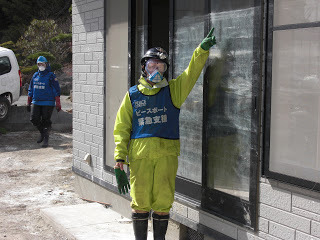 tsunami mark on a house Cars were upended and littered everywhere. Homes were bashed in; belongings were strewn everywhere.
tsunami mark on a house Cars were upended and littered everywhere. Homes were bashed in; belongings were strewn everywhere.



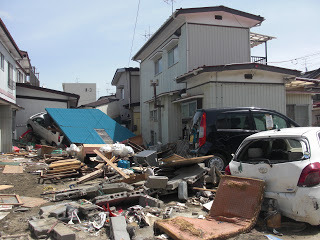 The wind that afternoon was fierce, whipping through the deserted neighborhoods. At one point while picking up and bagging rotting fish in the parking lot, I paused and turned slowly about in a circle surveying the haunting sights. The wind howled around me. Debris slammed and banged and tumbled across the ground. The stench of rotting fish permeated everything. The devastation was terrifying and I wept, inside my goggles and mask, unable to wipe away my tears. The district was so like Kamakura and many of the other towns in Japan I love, nestled between hills and sea. I ached for everyone who lived there...or had lived there.
The wind that afternoon was fierce, whipping through the deserted neighborhoods. At one point while picking up and bagging rotting fish in the parking lot, I paused and turned slowly about in a circle surveying the haunting sights. The wind howled around me. Debris slammed and banged and tumbled across the ground. The stench of rotting fish permeated everything. The devastation was terrifying and I wept, inside my goggles and mask, unable to wipe away my tears. The district was so like Kamakura and many of the other towns in Japan I love, nestled between hills and sea. I ached for everyone who lived there...or had lived there.
We worked until 4 p.m. then returned to the hospital and took photos of our guides as we waited for a turn to be sprayed by the high-pressure hose.
 our Ibarazu guides from the Yama Umi Kawa (Mountain Sea River) groupWhen I reached my tent, I was dismayed to discover that one of my tent poles had snapped in the high winds and poked holes in the tent fly. My team helped with an innovative repair job involving a piece of PVC pipe, gum tape and a thick sock.
our Ibarazu guides from the Yama Umi Kawa (Mountain Sea River) groupWhen I reached my tent, I was dismayed to discover that one of my tent poles had snapped in the high winds and poked holes in the tent fly. My team helped with an innovative repair job involving a piece of PVC pipe, gum tape and a thick sock.
Once again the meal truck was there and served us hot soup and rice. That evening after our leader returned from the nightly team leader meeting, we sat around the tent talking. We had volunteered to return the following morning for more fish work, eager to help Ibarazu for another day.
Soon after everyone went off to sleep we had a small quake, shindo 3. Strange to feel it while sitting on the ground, with no building noise around, just the earth quietly flexing.
I checked my tent stakes carefully, hoped for a calm night, then dreamed fish dreams.
The rain stopped but a strong wind came up around 3 a.m. The tent leaned and flapped in the powerful gusts. I stepped outside to stomp on all my tent stakes and hoped they would hold. Then I waited for dawn; there was no chance of any more sleep in that wind.
Morning meeting was at 7:30 as usual, followed by exercises and explanations of team assignments.
Our team, like many teams that day, was assigned to help pick up fish in the district of Ibarazu; about 60 volunteers were bused to Ibarazu where the tsunami had plowed through a major fish market and deposited 170,000 tons of fish of all varieties among the houses, on the roads, in and beneath the mangled cars, and in the trees. Our task was to help pick up and bag the stinking, rotting fish.
At our base, a small hospital, we were divided into groups of two or three teams, and with local guides we walked about the town, stopping to bag fish wherever the biggest deposits were and to heave the oozing bags into a truck bed.
 fishing...note the truck already heaped with bags of rotting fishOur first task was the worst--sorting through a reeking pile of fish and debris just outside a home to find the fish and even to rebag rotting fish that had been improperly bagged with debris.
fishing...note the truck already heaped with bags of rotting fishOur first task was the worst--sorting through a reeking pile of fish and debris just outside a home to find the fish and even to rebag rotting fish that had been improperly bagged with debris.We spoke with our guide as we walked about the district; he had spent a month in an evacuation center then had moved back, eager to be home. The entire first story of his lovely Japanese-style house was ruined and now under reconstruction. He somehow had running water, so we were able to hose off some of the fish goo before our lunch break.
 our base at the hospital
our base at the hospital
 just outside the hospital's entranceIn the afternoon we worked in a parking lot by the hospital; the lot was covered with fish and tsunami sludge embedded with fish.
just outside the hospital's entranceIn the afternoon we worked in a parking lot by the hospital; the lot was covered with fish and tsunami sludge embedded with fish. Ibarazu had been hit hard by the tsunami.
Ibarazu had been hit hard by the tsunami. tsunami mark on a house Cars were upended and littered everywhere. Homes were bashed in; belongings were strewn everywhere.
tsunami mark on a house Cars were upended and littered everywhere. Homes were bashed in; belongings were strewn everywhere.


 The wind that afternoon was fierce, whipping through the deserted neighborhoods. At one point while picking up and bagging rotting fish in the parking lot, I paused and turned slowly about in a circle surveying the haunting sights. The wind howled around me. Debris slammed and banged and tumbled across the ground. The stench of rotting fish permeated everything. The devastation was terrifying and I wept, inside my goggles and mask, unable to wipe away my tears. The district was so like Kamakura and many of the other towns in Japan I love, nestled between hills and sea. I ached for everyone who lived there...or had lived there.
The wind that afternoon was fierce, whipping through the deserted neighborhoods. At one point while picking up and bagging rotting fish in the parking lot, I paused and turned slowly about in a circle surveying the haunting sights. The wind howled around me. Debris slammed and banged and tumbled across the ground. The stench of rotting fish permeated everything. The devastation was terrifying and I wept, inside my goggles and mask, unable to wipe away my tears. The district was so like Kamakura and many of the other towns in Japan I love, nestled between hills and sea. I ached for everyone who lived there...or had lived there.We worked until 4 p.m. then returned to the hospital and took photos of our guides as we waited for a turn to be sprayed by the high-pressure hose.
 our Ibarazu guides from the Yama Umi Kawa (Mountain Sea River) groupWhen I reached my tent, I was dismayed to discover that one of my tent poles had snapped in the high winds and poked holes in the tent fly. My team helped with an innovative repair job involving a piece of PVC pipe, gum tape and a thick sock.
our Ibarazu guides from the Yama Umi Kawa (Mountain Sea River) groupWhen I reached my tent, I was dismayed to discover that one of my tent poles had snapped in the high winds and poked holes in the tent fly. My team helped with an innovative repair job involving a piece of PVC pipe, gum tape and a thick sock. Once again the meal truck was there and served us hot soup and rice. That evening after our leader returned from the nightly team leader meeting, we sat around the tent talking. We had volunteered to return the following morning for more fish work, eager to help Ibarazu for another day.
Soon after everyone went off to sleep we had a small quake, shindo 3. Strange to feel it while sitting on the ground, with no building noise around, just the earth quietly flexing.
I checked my tent stakes carefully, hoped for a calm night, then dreamed fish dreams.
Published on May 10, 2011 04:26
May 9, 2011
Ishinomaki Day 2
Following is Day 2 of my week in Tohoku volunteering with the NGO Peace Boat in the tsunami-devastated city of Ishinomaki, Miyagi Prefecture.
I woke at 5:30 a.m. to light rain. Others on the campground were already up and about. I ate granola in my tent and organized for the day. At 7:30 all volunteers reported for the morning meeting where we heard explanations of the day's work and spread out across the parking lot to do our rajio taiso--radio exercises. Although this custom may seem silly or extraneous to some, volunteers all enjoyed this communal start to the day, and the stretching and movement helped loosen our stiff, sore muscles.
At 9 a.m. we were bused to the Peace Boat base at Ai Plaza where we gathered our tools, learned about our assignment and headed off with wheelbarrows to the site where three teams were to work on cleaning out three bars set off a deep inner corridor.
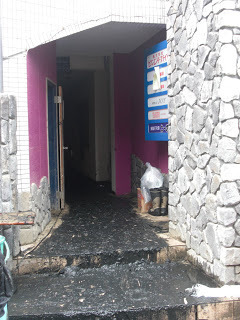 The oily sludge was 10-15 centimeters deep in the bar our team was assigned to, and the high-water mark on the walls was well above my head. Tables, chairs and sofas were tumbled and heaped in a mess, and broken bottles, magazines, ash trays, dishes and odds and ends were everywhere. Again, our headlamps were essential in the dark room. We started by removing the furniture and debris, including one large fish, and shoveled the floor as we went. We were soon coated, head to foot, in black goo. Check out my yellow-green suit...
The oily sludge was 10-15 centimeters deep in the bar our team was assigned to, and the high-water mark on the walls was well above my head. Tables, chairs and sofas were tumbled and heaped in a mess, and broken bottles, magazines, ash trays, dishes and odds and ends were everywhere. Again, our headlamps were essential in the dark room. We started by removing the furniture and debris, including one large fish, and shoveled the floor as we went. We were soon coated, head to foot, in black goo. Check out my yellow-green suit...
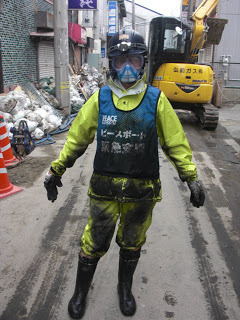
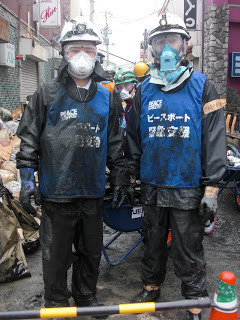 We were sprayed somewhat clean for our much needed lunch break at Ai Plaza. Nuts, dried fruits, granola bars, bread, chocolate and other simple easy to carry foods made up our lunches.
We were sprayed somewhat clean for our much needed lunch break at Ai Plaza. Nuts, dried fruits, granola bars, bread, chocolate and other simple easy to carry foods made up our lunches.
 In the afternoon we continued with furniture removal, shoveling mud, bagging it, dragging it down the corridor, lifting it onto wheelbarrows, then wheeling it to the massive piles.
In the afternoon we continued with furniture removal, shoveling mud, bagging it, dragging it down the corridor, lifting it onto wheelbarrows, then wheeling it to the massive piles.
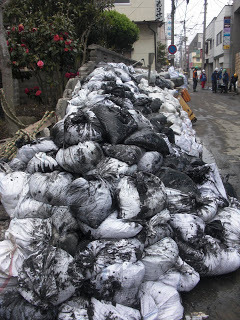 We stopped work at 4, having shoveled out the main room of the bar, the bar kitchen, a small lounge room, and a toilet. The place was still filthy and coated in dirt, but at least the initial sludge removal was done. We were sprayed semi-clean by the bar owner.
We stopped work at 4, having shoveled out the main room of the bar, the bar kitchen, a small lounge room, and a toilet. The place was still filthy and coated in dirt, but at least the initial sludge removal was done. We were sprayed semi-clean by the bar owner.
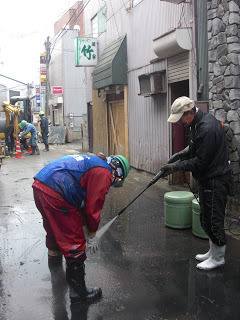 At the clean station we were power sprayed again before returning to Ai Plaza, tired and chilled. Fortunately there was a fire in a hearth at Ai Plaza with cans of coffee heating for us in a pan of water.
At the clean station we were power sprayed again before returning to Ai Plaza, tired and chilled. Fortunately there was a fire in a hearth at Ai Plaza with cans of coffee heating for us in a pan of water.
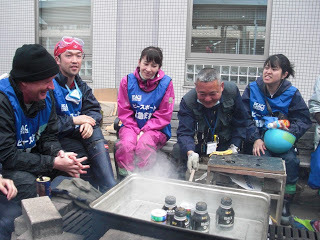 Back at the university campsite, we were particularly grateful that evening to see the food truck set up with hot miso vegetable soup and full bento dinners for volunteers--a Golden Week perk we were told. The rain soon returned though, so our team ate, chatted and drank tea in my tent.
Back at the university campsite, we were particularly grateful that evening to see the food truck set up with hot miso vegetable soup and full bento dinners for volunteers--a Golden Week perk we were told. The rain soon returned though, so our team ate, chatted and drank tea in my tent.
That evening we discovered the base tent of the contractors from Osaka who, with some car batteries, could charge our cell phones much faster than any of the charging devices we'd brought with us.
Soon it was pouring, and as we each dropped off to an exhausted sleep, we hoped our tents would keep us dry.
I woke at 5:30 a.m. to light rain. Others on the campground were already up and about. I ate granola in my tent and organized for the day. At 7:30 all volunteers reported for the morning meeting where we heard explanations of the day's work and spread out across the parking lot to do our rajio taiso--radio exercises. Although this custom may seem silly or extraneous to some, volunteers all enjoyed this communal start to the day, and the stretching and movement helped loosen our stiff, sore muscles.
At 9 a.m. we were bused to the Peace Boat base at Ai Plaza where we gathered our tools, learned about our assignment and headed off with wheelbarrows to the site where three teams were to work on cleaning out three bars set off a deep inner corridor.
 The oily sludge was 10-15 centimeters deep in the bar our team was assigned to, and the high-water mark on the walls was well above my head. Tables, chairs and sofas were tumbled and heaped in a mess, and broken bottles, magazines, ash trays, dishes and odds and ends were everywhere. Again, our headlamps were essential in the dark room. We started by removing the furniture and debris, including one large fish, and shoveled the floor as we went. We were soon coated, head to foot, in black goo. Check out my yellow-green suit...
The oily sludge was 10-15 centimeters deep in the bar our team was assigned to, and the high-water mark on the walls was well above my head. Tables, chairs and sofas were tumbled and heaped in a mess, and broken bottles, magazines, ash trays, dishes and odds and ends were everywhere. Again, our headlamps were essential in the dark room. We started by removing the furniture and debris, including one large fish, and shoveled the floor as we went. We were soon coated, head to foot, in black goo. Check out my yellow-green suit...
 We were sprayed somewhat clean for our much needed lunch break at Ai Plaza. Nuts, dried fruits, granola bars, bread, chocolate and other simple easy to carry foods made up our lunches.
We were sprayed somewhat clean for our much needed lunch break at Ai Plaza. Nuts, dried fruits, granola bars, bread, chocolate and other simple easy to carry foods made up our lunches. In the afternoon we continued with furniture removal, shoveling mud, bagging it, dragging it down the corridor, lifting it onto wheelbarrows, then wheeling it to the massive piles.
In the afternoon we continued with furniture removal, shoveling mud, bagging it, dragging it down the corridor, lifting it onto wheelbarrows, then wheeling it to the massive piles. We stopped work at 4, having shoveled out the main room of the bar, the bar kitchen, a small lounge room, and a toilet. The place was still filthy and coated in dirt, but at least the initial sludge removal was done. We were sprayed semi-clean by the bar owner.
We stopped work at 4, having shoveled out the main room of the bar, the bar kitchen, a small lounge room, and a toilet. The place was still filthy and coated in dirt, but at least the initial sludge removal was done. We were sprayed semi-clean by the bar owner. At the clean station we were power sprayed again before returning to Ai Plaza, tired and chilled. Fortunately there was a fire in a hearth at Ai Plaza with cans of coffee heating for us in a pan of water.
At the clean station we were power sprayed again before returning to Ai Plaza, tired and chilled. Fortunately there was a fire in a hearth at Ai Plaza with cans of coffee heating for us in a pan of water. Back at the university campsite, we were particularly grateful that evening to see the food truck set up with hot miso vegetable soup and full bento dinners for volunteers--a Golden Week perk we were told. The rain soon returned though, so our team ate, chatted and drank tea in my tent.
Back at the university campsite, we were particularly grateful that evening to see the food truck set up with hot miso vegetable soup and full bento dinners for volunteers--a Golden Week perk we were told. The rain soon returned though, so our team ate, chatted and drank tea in my tent.That evening we discovered the base tent of the contractors from Osaka who, with some car batteries, could charge our cell phones much faster than any of the charging devices we'd brought with us.
Soon it was pouring, and as we each dropped off to an exhausted sleep, we hoped our tents would keep us dry.
Published on May 09, 2011 05:03
May 8, 2011
Ishinomaki Day 1
I recently returned from a week in Tohoku volunteering with the NGO Peace Boat in the tsunami-devastated city of Ishinomaki, Miyagi Prefecture. For the next week I'll be posting day by day accounts of my experience.
On Friday evening, volunteers assembled in preassigned teams of six with all their gear in Shinjuku, Tokyo. Though I can speak Japanese, I opted to join an international, mostly bilingual team for this first trip to Tohoku. Volunteers traveled by overnight bus to Ishinomaki Senshu University--10 buses carrying over 350 volunteers of many nationalities who'd come from all over Japan and abroad.
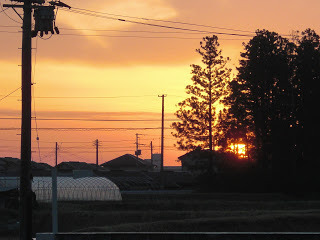 sunrise on the way to Ishinomaki
sunrise on the way to Ishinomaki
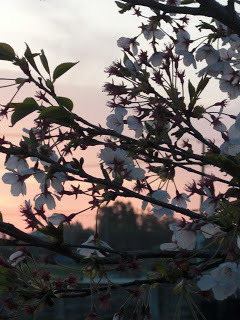 cherry blossoms at a rest area
cherry blossoms at a rest area
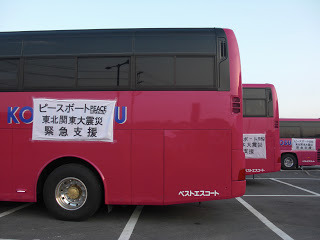 Peace Boat busesWe arrived in Ishinomaki at 8:30 am, unloaded our gear and listened to instructions from Peace Boat staff.
Peace Boat busesWe arrived in Ishinomaki at 8:30 am, unloaded our gear and listened to instructions from Peace Boat staff.
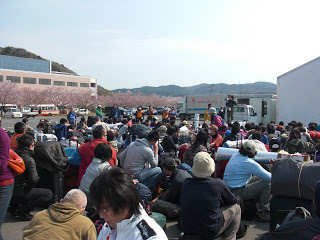 volunteers receiving instructions on arrivalWe set up our tents on the campus grounds around the university track.
volunteers receiving instructions on arrivalWe set up our tents on the campus grounds around the university track.
 the university track team practiced despite the upheaval around them
the university track team practiced despite the upheaval around them
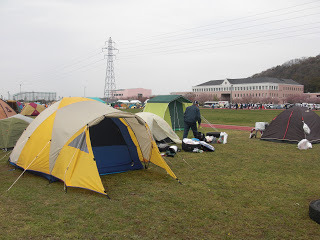 my homeAt 11:30 our team reported to duty, suited up in rain suits and safety boots. A bus took us to Peace Boat's base at Ai Plaza in the center of the city where we heard detailed explanations of the type of work we would do, how to keep safe, etc. Each team gathered wheelbarrows, shovels, trowels, brooms, bags for mud and debris and set off to an assigned location.
my homeAt 11:30 our team reported to duty, suited up in rain suits and safety boots. A bus took us to Peace Boat's base at Ai Plaza in the center of the city where we heard detailed explanations of the type of work we would do, how to keep safe, etc. Each team gathered wheelbarrows, shovels, trowels, brooms, bags for mud and debris and set off to an assigned location.
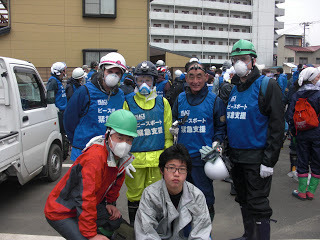 the last time my yellow-green suit was cleanOur first day's task was to clean out a movie theater--remove the seats, shovel the oily sludge into bags, haul them outside, and scrape the floor clean. Headlamps were our only source of light.
the last time my yellow-green suit was cleanOur first day's task was to clean out a movie theater--remove the seats, shovel the oily sludge into bags, haul them outside, and scrape the floor clean. Headlamps were our only source of light.
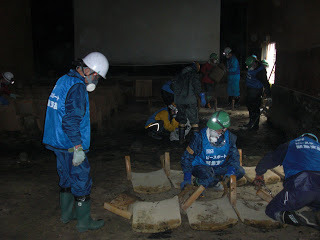 removing chairs from the theater
removing chairs from the theater
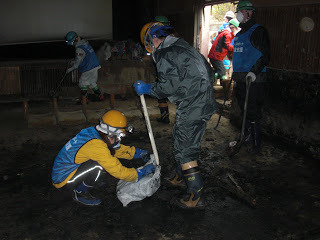 bagging sludge
bagging sludge
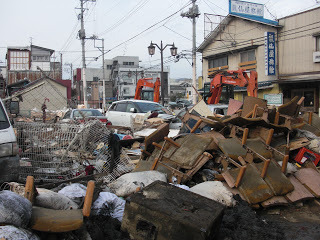 heaps of sludge bags and debris
heaps of sludge bags and debris
 nearby temple grounds filled with debrisThe center of Ishinomaki City was hit by the overflowing river caused by the tsunami--the flood line reached up to the second story of buildings. Debris was piled everywhere, and many buildings were badly damaged.
nearby temple grounds filled with debrisThe center of Ishinomaki City was hit by the overflowing river caused by the tsunami--the flood line reached up to the second story of buildings. Debris was piled everywhere, and many buildings were badly damaged.
 damaged building, muddy road
damaged building, muddy road
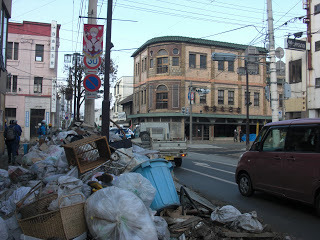 debris and damaged buildingsWe worked at the movie theater all afternoon then hauled ourselves and our tools to the clean station to be hosed off.
debris and damaged buildingsWe worked at the movie theater all afternoon then hauled ourselves and our tools to the clean station to be hosed off.
 the clean station
the clean station
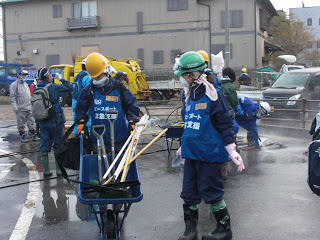 clothes and tools all hosed off From there we walked back to Ai Plaza, past the manga characters, to leave our tools and take a bus back to the university.
clothes and tools all hosed off From there we walked back to Ai Plaza, past the manga characters, to leave our tools and take a bus back to the university.
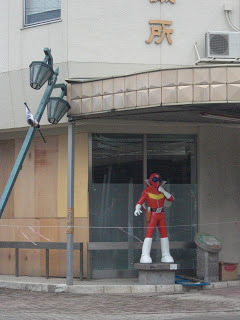 on Ishinomaki's main street
on Ishinomaki's main street
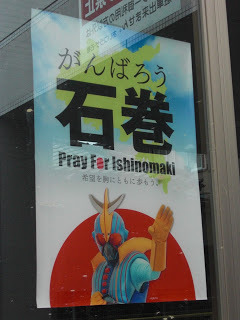 a poster for IshinomakiAt the camp site, we quickly set up cook stoves to fix noodles and other quick foods and were also served soba and salad by a food truck supporting volunteers. By 9 pm the grounds were quiet--everyone exhausted from the overnight trip and the first day's work. The temperature dropped fast at night--I made good use of a small hot water bottle and adhesive Hokaron warmers throughout my week in Ishinomaki.
a poster for IshinomakiAt the camp site, we quickly set up cook stoves to fix noodles and other quick foods and were also served soba and salad by a food truck supporting volunteers. By 9 pm the grounds were quiet--everyone exhausted from the overnight trip and the first day's work. The temperature dropped fast at night--I made good use of a small hot water bottle and adhesive Hokaron warmers throughout my week in Ishinomaki.
On Friday evening, volunteers assembled in preassigned teams of six with all their gear in Shinjuku, Tokyo. Though I can speak Japanese, I opted to join an international, mostly bilingual team for this first trip to Tohoku. Volunteers traveled by overnight bus to Ishinomaki Senshu University--10 buses carrying over 350 volunteers of many nationalities who'd come from all over Japan and abroad.
 sunrise on the way to Ishinomaki
sunrise on the way to Ishinomaki
 cherry blossoms at a rest area
cherry blossoms at a rest area
 Peace Boat busesWe arrived in Ishinomaki at 8:30 am, unloaded our gear and listened to instructions from Peace Boat staff.
Peace Boat busesWe arrived in Ishinomaki at 8:30 am, unloaded our gear and listened to instructions from Peace Boat staff. volunteers receiving instructions on arrivalWe set up our tents on the campus grounds around the university track.
volunteers receiving instructions on arrivalWe set up our tents on the campus grounds around the university track. the university track team practiced despite the upheaval around them
the university track team practiced despite the upheaval around them
 my homeAt 11:30 our team reported to duty, suited up in rain suits and safety boots. A bus took us to Peace Boat's base at Ai Plaza in the center of the city where we heard detailed explanations of the type of work we would do, how to keep safe, etc. Each team gathered wheelbarrows, shovels, trowels, brooms, bags for mud and debris and set off to an assigned location.
my homeAt 11:30 our team reported to duty, suited up in rain suits and safety boots. A bus took us to Peace Boat's base at Ai Plaza in the center of the city where we heard detailed explanations of the type of work we would do, how to keep safe, etc. Each team gathered wheelbarrows, shovels, trowels, brooms, bags for mud and debris and set off to an assigned location.  the last time my yellow-green suit was cleanOur first day's task was to clean out a movie theater--remove the seats, shovel the oily sludge into bags, haul them outside, and scrape the floor clean. Headlamps were our only source of light.
the last time my yellow-green suit was cleanOur first day's task was to clean out a movie theater--remove the seats, shovel the oily sludge into bags, haul them outside, and scrape the floor clean. Headlamps were our only source of light.  removing chairs from the theater
removing chairs from the theater
 bagging sludge
bagging sludge
 heaps of sludge bags and debris
heaps of sludge bags and debris
 nearby temple grounds filled with debrisThe center of Ishinomaki City was hit by the overflowing river caused by the tsunami--the flood line reached up to the second story of buildings. Debris was piled everywhere, and many buildings were badly damaged.
nearby temple grounds filled with debrisThe center of Ishinomaki City was hit by the overflowing river caused by the tsunami--the flood line reached up to the second story of buildings. Debris was piled everywhere, and many buildings were badly damaged. damaged building, muddy road
damaged building, muddy road debris and damaged buildingsWe worked at the movie theater all afternoon then hauled ourselves and our tools to the clean station to be hosed off.
debris and damaged buildingsWe worked at the movie theater all afternoon then hauled ourselves and our tools to the clean station to be hosed off. the clean station
the clean station clothes and tools all hosed off From there we walked back to Ai Plaza, past the manga characters, to leave our tools and take a bus back to the university.
clothes and tools all hosed off From there we walked back to Ai Plaza, past the manga characters, to leave our tools and take a bus back to the university.  on Ishinomaki's main street
on Ishinomaki's main street
 a poster for IshinomakiAt the camp site, we quickly set up cook stoves to fix noodles and other quick foods and were also served soba and salad by a food truck supporting volunteers. By 9 pm the grounds were quiet--everyone exhausted from the overnight trip and the first day's work. The temperature dropped fast at night--I made good use of a small hot water bottle and adhesive Hokaron warmers throughout my week in Ishinomaki.
a poster for IshinomakiAt the camp site, we quickly set up cook stoves to fix noodles and other quick foods and were also served soba and salad by a food truck supporting volunteers. By 9 pm the grounds were quiet--everyone exhausted from the overnight trip and the first day's work. The temperature dropped fast at night--I made good use of a small hot water bottle and adhesive Hokaron warmers throughout my week in Ishinomaki.
Published on May 08, 2011 05:58
April 24, 2011
What We Do Now
Classes at my university have begun, cherry blossoms have come and gone, and we move into a new future here in Japan. Efforts to save power continue, the mood is subdued, and we remain on alert--a strong gust of wind through my classroom last week had all my students suddenly gripping their desks--another earthquake? Tremors continue to rattle us, but this past week was quieter than the week before. Knock wood.
There are heartening signs that people are out and about and supporting local economies again. Here in Kamakura, visitors are touring temples and gardens, gathering in groups at the shore, meeting in restaurants, and even, once again, getting stuck in traffic jams. The coast, of course, remains as gorgeous as ever.
 from Morito Shrine in HayamaI am awed by the energy around me. Charity events. Book collections for children in Tohoku. Clothing and food collections. Anthology fund raisers. Auctions. Fine art, photography, dance and music projects to raise money for communities affected by the March 11 earthquake.
from Morito Shrine in HayamaI am awed by the energy around me. Charity events. Book collections for children in Tohoku. Clothing and food collections. Anthology fund raisers. Auctions. Fine art, photography, dance and music projects to raise money for communities affected by the March 11 earthquake.
So far I have donated money online, via auctions and in the ubiquitous donation boxes; I have donated books; I have contributed my writing to benefit anthologies; I have put together my own benefit writing project; I have been working to determine how best to use SCBWI relief grant money. And perhaps most importantly, I have signed up to serve as a volunteer with the NGO Peace Boat (website, blog, Facebook) to help with relief efforts in Ishinomaki (Miyagi Prefecture), a city badly hit by the massive tsunami (and if you need a reminder of the power of that tsunami here's a video).
The past week has been consumed by preparations for my upcoming trip to Ishinomaki. Each Peace Boat volunteer must bring his or her own tent, food, water and supplies for a week, as well as clothes and gear for clean-up work--safety goggles, headlamp, waterproof jacket and pants, steel-toed rubber boots. The aim is to be self-sufficient so as not to add any further burden to the hard-hit communities or consume any of their precious resources.
I have been gathering what I need and have a heap of stuff that must all somehow fit into one large backpack plus a daypack. I've checked the tent, cleaned the sleeping bag, rerolled my mats, and tested the stove. In addition to easy-to-prepare foods and my work gear, I've purchased a radio, a battery charger for my iPhone (they were all out of solar), an extra headlamp, masks for dusty work, insoles for the boots, dry shampoo and shower sheets....and water...one alloted 2-liter bottle at a time from the supermarket. Somehow this heap of stuff plus clothes needs to be organized into two backpacks, more or less.
 heap of just some of the gear for my Ishinomaki tripAlthough I'm daunted by the physical and mental challenges I'll face in Ishinomaki, I look forward to helping on site. On Saturday evening at the second Peace Boat Orientation meeting, attended by about 300 people, I met my team members--we work in teams of six. It was reassuring to put names to the faces of the people I'll work beside--Japanese, Japanese-American, Australian, French, American (I opted for an international group). The 300 volunteers will travel by overnight bus convoy to Ishinomaki, just one of many needy communities along the hard-hit coast Tohoku. Volunteers will camp on the grounds of Ishinomaki Senshuu University, and for a week we will be involved mostly in clean-up work--shoveling mud and clearing tsunami-strewn debris.
heap of just some of the gear for my Ishinomaki tripAlthough I'm daunted by the physical and mental challenges I'll face in Ishinomaki, I look forward to helping on site. On Saturday evening at the second Peace Boat Orientation meeting, attended by about 300 people, I met my team members--we work in teams of six. It was reassuring to put names to the faces of the people I'll work beside--Japanese, Japanese-American, Australian, French, American (I opted for an international group). The 300 volunteers will travel by overnight bus convoy to Ishinomaki, just one of many needy communities along the hard-hit coast Tohoku. Volunteers will camp on the grounds of Ishinomaki Senshuu University, and for a week we will be involved mostly in clean-up work--shoveling mud and clearing tsunami-strewn debris.
But this clean-up effort is a monumental task that will take not just a week but months and years. I imagine this will be my first trip of many. This is, after all, what we do now, post 3/11.
There are heartening signs that people are out and about and supporting local economies again. Here in Kamakura, visitors are touring temples and gardens, gathering in groups at the shore, meeting in restaurants, and even, once again, getting stuck in traffic jams. The coast, of course, remains as gorgeous as ever.
 from Morito Shrine in HayamaI am awed by the energy around me. Charity events. Book collections for children in Tohoku. Clothing and food collections. Anthology fund raisers. Auctions. Fine art, photography, dance and music projects to raise money for communities affected by the March 11 earthquake.
from Morito Shrine in HayamaI am awed by the energy around me. Charity events. Book collections for children in Tohoku. Clothing and food collections. Anthology fund raisers. Auctions. Fine art, photography, dance and music projects to raise money for communities affected by the March 11 earthquake.So far I have donated money online, via auctions and in the ubiquitous donation boxes; I have donated books; I have contributed my writing to benefit anthologies; I have put together my own benefit writing project; I have been working to determine how best to use SCBWI relief grant money. And perhaps most importantly, I have signed up to serve as a volunteer with the NGO Peace Boat (website, blog, Facebook) to help with relief efforts in Ishinomaki (Miyagi Prefecture), a city badly hit by the massive tsunami (and if you need a reminder of the power of that tsunami here's a video).
The past week has been consumed by preparations for my upcoming trip to Ishinomaki. Each Peace Boat volunteer must bring his or her own tent, food, water and supplies for a week, as well as clothes and gear for clean-up work--safety goggles, headlamp, waterproof jacket and pants, steel-toed rubber boots. The aim is to be self-sufficient so as not to add any further burden to the hard-hit communities or consume any of their precious resources.
I have been gathering what I need and have a heap of stuff that must all somehow fit into one large backpack plus a daypack. I've checked the tent, cleaned the sleeping bag, rerolled my mats, and tested the stove. In addition to easy-to-prepare foods and my work gear, I've purchased a radio, a battery charger for my iPhone (they were all out of solar), an extra headlamp, masks for dusty work, insoles for the boots, dry shampoo and shower sheets....and water...one alloted 2-liter bottle at a time from the supermarket. Somehow this heap of stuff plus clothes needs to be organized into two backpacks, more or less.
 heap of just some of the gear for my Ishinomaki tripAlthough I'm daunted by the physical and mental challenges I'll face in Ishinomaki, I look forward to helping on site. On Saturday evening at the second Peace Boat Orientation meeting, attended by about 300 people, I met my team members--we work in teams of six. It was reassuring to put names to the faces of the people I'll work beside--Japanese, Japanese-American, Australian, French, American (I opted for an international group). The 300 volunteers will travel by overnight bus convoy to Ishinomaki, just one of many needy communities along the hard-hit coast Tohoku. Volunteers will camp on the grounds of Ishinomaki Senshuu University, and for a week we will be involved mostly in clean-up work--shoveling mud and clearing tsunami-strewn debris.
heap of just some of the gear for my Ishinomaki tripAlthough I'm daunted by the physical and mental challenges I'll face in Ishinomaki, I look forward to helping on site. On Saturday evening at the second Peace Boat Orientation meeting, attended by about 300 people, I met my team members--we work in teams of six. It was reassuring to put names to the faces of the people I'll work beside--Japanese, Japanese-American, Australian, French, American (I opted for an international group). The 300 volunteers will travel by overnight bus convoy to Ishinomaki, just one of many needy communities along the hard-hit coast Tohoku. Volunteers will camp on the grounds of Ishinomaki Senshuu University, and for a week we will be involved mostly in clean-up work--shoveling mud and clearing tsunami-strewn debris.But this clean-up effort is a monumental task that will take not just a week but months and years. I imagine this will be my first trip of many. This is, after all, what we do now, post 3/11.
Published on April 24, 2011 17:22
April 14, 2011
Blossom Break
This afternoon I took a much-needed blossom break from work and teaching prep and writing and myriad earthquake-related relief projects. I am reminded of just how much I love Kamakura and how lucky I feel to be here.
 Second torii at the start of the dankazura walkway
Second torii at the start of the dankazura walkway
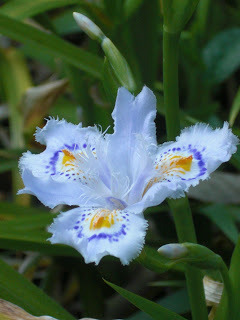 shaga (fringed iris)
shaga (fringed iris)
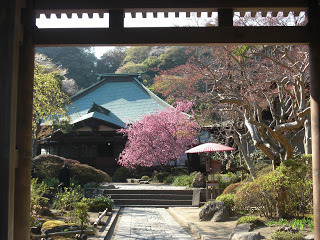 Kaizoji
Kaizoji
 where I wish I lived
where I wish I lived
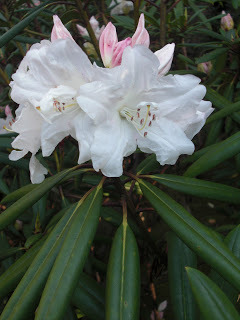 rhododendron
rhododendron
 hmm...yellow flowers
hmm...yellow flowers
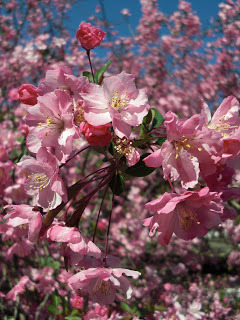 hanakaidou (flowering crab apple)
hanakaidou (flowering crab apple)
 yuki-yanagi (spirea)
yuki-yanagi (spirea)
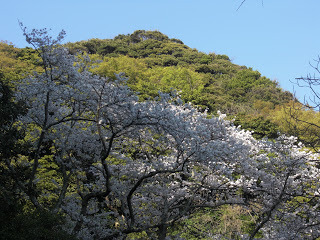 just west of Hachimangu
just west of Hachimangu
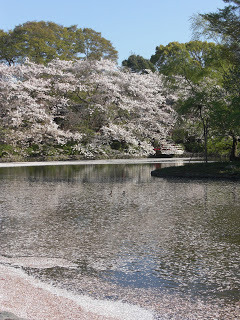 the Minamoto side of the Genpei pond at HachimanguAnd yes, those are sakura petals floating on the pond.
the Minamoto side of the Genpei pond at HachimanguAnd yes, those are sakura petals floating on the pond.

 Second torii at the start of the dankazura walkway
Second torii at the start of the dankazura walkway
 shaga (fringed iris)
shaga (fringed iris) Kaizoji
Kaizoji where I wish I lived
where I wish I lived rhododendron
rhododendron hmm...yellow flowers
hmm...yellow flowers
 hanakaidou (flowering crab apple)
hanakaidou (flowering crab apple)
 yuki-yanagi (spirea)
yuki-yanagi (spirea) just west of Hachimangu
just west of Hachimangu the Minamoto side of the Genpei pond at HachimanguAnd yes, those are sakura petals floating on the pond.
the Minamoto side of the Genpei pond at HachimanguAnd yes, those are sakura petals floating on the pond.
Published on April 14, 2011 03:44
April 7, 2011
Interview: Greg Fishbone, mastermind of Kidlit4Japan Auction
As mentioned in my post of March 13, I had arrived in Massachusetts the day before the Tohoku earthquake of March 11. It was a painful time to be away from Japan, but within days I had been contacted by author Greg Fishbone wondering what he could do. Whereas I was floundering, uncertain as to where and how I should focus my energy and concern, Greg took action immediately and set up the Kidlit4Japan auction (also mentioned in my earlier post here), which will continue through April 12. Despite the many hours he has been dedicating to the auction, he quickly agreed to this interview.
Holly: The Kidlit4Japan auction was launched on March 21, just ten days after the great Tohoku earthquake. How did you manage to set this idea in motion so quickly?
Greg: I began organizing on March 16th and you were actually the first person I contacted in order to get an idea of what was going on in Japan and where my efforts might make the most impact. After that, I put out the word about the possibility of doing an auction and the event came together at lightning speed because of all the big-hearted people in the children's literature community who rushed to pledge their support. Holly: Who are some of the key people behind the scenes of this Kidlit4Japan auction? Greg: Kidlit4Japan Central Office is just me and my laptop, but behind me are over a hundred authors, illustrators, editors, and agents who have donated items or services to the auction. We've had signed books, advance reader copies, artwork, critique services, and even the chance for a winning bidder to name a character in an upcoming book. In addition to that we've had generous and caring bidders, lots of folks sending out tweets and blog posts, and an amazing logo and badge designed by Edna Cabcabin Moran.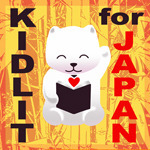 Holly: How much do you estimate has been raised from the Kidlit4Japan auction so far?
Holly: How much do you estimate has been raised from the Kidlit4Japan auction so far?
Greg: The current tally is $6,848 with a few days left to go.Holly: What do you think is the key to the success of this Kidlit4Japan auction? Do you have any tips for those trying similar endeavors? Greg: The key to success has been bringing people together so they can have more impact as a group than any one of them could have alone. My tip for others would be to use technology wherever it's appropriate. There are so many great tools available online!Holly: You have an upcoming story set in Japan. What is your connection to Japan? And will you be visiting Japan sometime soon?
Greg: I've always had an interest in Japan and Japanese culture, and jumped at an opportunity to live and study in Tokyo for half a year during law school. I was there during the great Hanshin earthquake and also the sarin gas attack on the Tokyo subway. Part of the first GALAXY GAMES book takes place during a chaotic few days when it seems like the world is coming to an end. A lot of it takes place in Japan, and many of the characters are Japanese or Japanese American. It might be that I was thinking about that time in my life when I felt completely helpless in the face of all the suffering that was occurring so close to me--but the book is also a celebration of the good experiences I associate with Japan: the culture, the sights, and the people. I would love to go back someday.
Holly: Thank you, Greg! We hope to see you in Japan again soon. And thank you for all that you are doing to raise funds and awareness on behalf of the quake-affected regions of Tohoku, Japan.
And here is a bit more about Greg... Greg R. Fishbone serves as Assistant Regional Coordinator for the three New England chapters of the Society of Children's Book Writers and Illustrators. He is the author of the upcoming GALAXY GAMES series from Lee & Low's SF/F imprint, Tu Books. Greg's hometown of Boston shaped his love of sports, history, and clam chowder. He also developed a healthy obsession with science fiction and fantasy stories. Between (and often during) classes, Greg doodled spaceships and plotted out his own early efforts at writing. After college, Greg attended law school in three countries, including Japan. And definitely check out the Kidlit4Japan auction.
Holly: The Kidlit4Japan auction was launched on March 21, just ten days after the great Tohoku earthquake. How did you manage to set this idea in motion so quickly?
Greg: I began organizing on March 16th and you were actually the first person I contacted in order to get an idea of what was going on in Japan and where my efforts might make the most impact. After that, I put out the word about the possibility of doing an auction and the event came together at lightning speed because of all the big-hearted people in the children's literature community who rushed to pledge their support. Holly: Who are some of the key people behind the scenes of this Kidlit4Japan auction? Greg: Kidlit4Japan Central Office is just me and my laptop, but behind me are over a hundred authors, illustrators, editors, and agents who have donated items or services to the auction. We've had signed books, advance reader copies, artwork, critique services, and even the chance for a winning bidder to name a character in an upcoming book. In addition to that we've had generous and caring bidders, lots of folks sending out tweets and blog posts, and an amazing logo and badge designed by Edna Cabcabin Moran.
 Holly: How much do you estimate has been raised from the Kidlit4Japan auction so far?
Holly: How much do you estimate has been raised from the Kidlit4Japan auction so far?Greg: The current tally is $6,848 with a few days left to go.Holly: What do you think is the key to the success of this Kidlit4Japan auction? Do you have any tips for those trying similar endeavors? Greg: The key to success has been bringing people together so they can have more impact as a group than any one of them could have alone. My tip for others would be to use technology wherever it's appropriate. There are so many great tools available online!Holly: You have an upcoming story set in Japan. What is your connection to Japan? And will you be visiting Japan sometime soon?
Greg: I've always had an interest in Japan and Japanese culture, and jumped at an opportunity to live and study in Tokyo for half a year during law school. I was there during the great Hanshin earthquake and also the sarin gas attack on the Tokyo subway. Part of the first GALAXY GAMES book takes place during a chaotic few days when it seems like the world is coming to an end. A lot of it takes place in Japan, and many of the characters are Japanese or Japanese American. It might be that I was thinking about that time in my life when I felt completely helpless in the face of all the suffering that was occurring so close to me--but the book is also a celebration of the good experiences I associate with Japan: the culture, the sights, and the people. I would love to go back someday.
Holly: Thank you, Greg! We hope to see you in Japan again soon. And thank you for all that you are doing to raise funds and awareness on behalf of the quake-affected regions of Tohoku, Japan.
And here is a bit more about Greg... Greg R. Fishbone serves as Assistant Regional Coordinator for the three New England chapters of the Society of Children's Book Writers and Illustrators. He is the author of the upcoming GALAXY GAMES series from Lee & Low's SF/F imprint, Tu Books. Greg's hometown of Boston shaped his love of sports, history, and clam chowder. He also developed a healthy obsession with science fiction and fantasy stories. Between (and often during) classes, Greg doodled spaceships and plotted out his own early efforts at writing. After college, Greg attended law school in three countries, including Japan. And definitely check out the Kidlit4Japan auction.
Published on April 07, 2011 00:22
April 6, 2011
Transformation
At first, everything seems unchanged in Kamakura, especially in brilliant spring sunlight. The newspaper deliveries make their rounds before dawn. The temple bells gong at six. The neighbors hang their laundry by eight. The trash is collected by nine. The wakame dries in the wind. The fishmongers lay cleaned and split fish to dry on screens. Shellfish gatherers fill buckets at low tide. Students begin the new academic year. Adults go to work. The cherry blossoms appear on hills, along roadsides, in gardens and parks everywhere.
And yet everything has changed. A deep and profound grief for all the people, property and livelihoods lost in Tohoku has set in. Restraint and caution pervade everyday life. Festivals and sports events are canceled. Blossom viewing parties frowned upon. Overseas tourists have vanished. World Heritage sites are quiet. Wary of train disruption people stay close to home. Lights are dimmed. Heaters off. Store shelves have gaping empty spans like empty lots that suddenly appear after a tear-down when we struggle to remember what was once there.
Yet in addition to restraint and caution is vibrant activism. Everyone we know is energetically fundraising, volunteering locally and in the quake-affected areas, offering homestays, donating goods, starting long-range projects to serve the people of Tohoku.
Writers, too, have been busy. Quakebook is an e-book collection of stories and artwork about March 11. Write for Tohoku is finalizing an e-book collection of essays about Japan. Authors for Japan in the U.K. raised over 12,000 pounds. Children's Authors and Illustrators for Japan led by author Greg Fishbone has already raised thousands of dollars through an online auction which continues through April 11.
Recovery in and around the quake and tsunami devastated areas will take years and needs our active support. Do what you can to give. Start your own fundraising projects or join others at school, work, among your friends. Find your way to give to the people of Tohoku.
And yet everything has changed. A deep and profound grief for all the people, property and livelihoods lost in Tohoku has set in. Restraint and caution pervade everyday life. Festivals and sports events are canceled. Blossom viewing parties frowned upon. Overseas tourists have vanished. World Heritage sites are quiet. Wary of train disruption people stay close to home. Lights are dimmed. Heaters off. Store shelves have gaping empty spans like empty lots that suddenly appear after a tear-down when we struggle to remember what was once there.
Yet in addition to restraint and caution is vibrant activism. Everyone we know is energetically fundraising, volunteering locally and in the quake-affected areas, offering homestays, donating goods, starting long-range projects to serve the people of Tohoku.
Writers, too, have been busy. Quakebook is an e-book collection of stories and artwork about March 11. Write for Tohoku is finalizing an e-book collection of essays about Japan. Authors for Japan in the U.K. raised over 12,000 pounds. Children's Authors and Illustrators for Japan led by author Greg Fishbone has already raised thousands of dollars through an online auction which continues through April 11.
Recovery in and around the quake and tsunami devastated areas will take years and needs our active support. Do what you can to give. Start your own fundraising projects or join others at school, work, among your friends. Find your way to give to the people of Tohoku.
Published on April 06, 2011 17:12
March 31, 2011
Readings, Research, SCBWI
I arrived in the U.S. from Japan the day before the Tohoku-Kanto earthquake for what I'd thought would be a brief trip of readings, research and SCBWI work retreat. After the quake, I ended up extending my stay. Today, I was scheduled to return to Japan at last, but my flight was canceled. I'll try again tomorrow. Meanwhile, this is a good time to highlight a few people and places from this trip.
On March 11, the day of the quake, I was lucky to be surrounded by Massachusetts friends new and old, as well as many family members, when I gave a reading at the incredible Concord Bookshop. In attendance were children's author Amy Gordon, with whom I taught at the Bement School, and Paul Harding, author of Tinkers, for whom I actually babysat in my teen years.
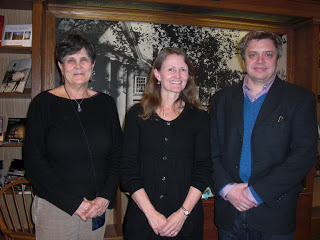 With authors Amy Gordon and Paul Harding at the Concord BookshopA few days later I gave a reading in Northampton at the Congregation B'nai Israel Synagogue Library where I was pleased to see Corinne Demas, my creative writing professor from Mount Holyoke College.
With authors Amy Gordon and Paul Harding at the Concord BookshopA few days later I gave a reading in Northampton at the Congregation B'nai Israel Synagogue Library where I was pleased to see Corinne Demas, my creative writing professor from Mount Holyoke College.
 With author Corinne Demas While in Massachusetts, I was able to see another great performance by the Angkor Dance Troupe.
With author Corinne Demas While in Massachusetts, I was able to see another great performance by the Angkor Dance Troupe.
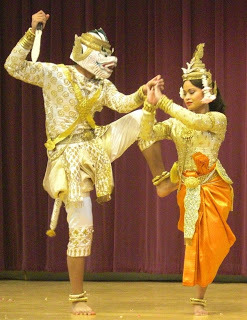 Hanuman the Monkey King and Sovann Machha the Golden MermaidI also had a chance to explore Lowell a bit more. Here at the Holy Trinity Greek Orthodox Church, a Greek man who spoke little English openly wept for Tohoku's tsunami and quake victims when he learned that I live in Japan.
Hanuman the Monkey King and Sovann Machha the Golden MermaidI also had a chance to explore Lowell a bit more. Here at the Holy Trinity Greek Orthodox Church, a Greek man who spoke little English openly wept for Tohoku's tsunami and quake victims when he learned that I live in Japan.
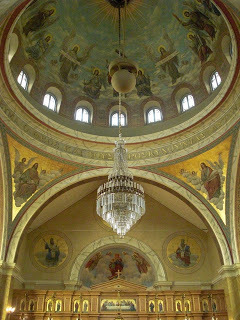 Holy Trinity Greek Orthodox Church, Lowell, MANext I went down to Florida from where I boarded a cruise ship for the SCBWI working retreat for regional advisors. Here a few of us are gathered just before setting sail.
Holy Trinity Greek Orthodox Church, Lowell, MANext I went down to Florida from where I boarded a cruise ship for the SCBWI working retreat for regional advisors. Here a few of us are gathered just before setting sail.
 With writers Chris Cheng, Lee Wind, Linda Rodriguez BernfeldFor a few days I focused on SCBWI and squeezed in a few much appreciated minutes of R&R and some good walking in Nassau
With writers Chris Cheng, Lee Wind, Linda Rodriguez BernfeldFor a few days I focused on SCBWI and squeezed in a few much appreciated minutes of R&R and some good walking in Nassau

 and on deck.
and on deck.
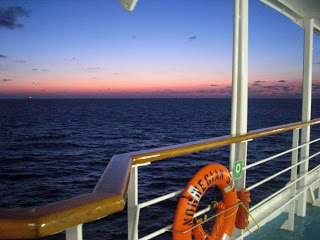 After the SCBWI retreat, I returned to Massachusetts and holed up inside to finish a full draft of my new verse novel. Then I made a quick trip to New York City where I was able to meet with my Los Angeles-based agent Jamie Weiss Chilton.
After the SCBWI retreat, I returned to Massachusetts and holed up inside to finish a full draft of my new verse novel. Then I made a quick trip to New York City where I was able to meet with my Los Angeles-based agent Jamie Weiss Chilton.
 With my agent Jamie Weiss Chilton of the Andrea Brown Literary AgencyThen I wandered around NYU, where long ago I attended the Creative Writing Program, and sat in Washington Square Park where the arch seemed to have grown.
With my agent Jamie Weiss Chilton of the Andrea Brown Literary AgencyThen I wandered around NYU, where long ago I attended the Creative Writing Program, and sat in Washington Square Park where the arch seemed to have grown.
 I also made a lightning quick visit to the town of Croton-on-Hudson where we lived once-upon-a-time and where snow melt was coursing over the ever impressive dam.
I also made a lightning quick visit to the town of Croton-on-Hudson where we lived once-upon-a-time and where snow melt was coursing over the ever impressive dam.
 Back in Massachusetts I managed to squeeze in a late afternoon walk to the one of my favorite locations on Essex River amid the Great Salt Marsh...brilliant in the March stillness.
Back in Massachusetts I managed to squeeze in a late afternoon walk to the one of my favorite locations on Essex River amid the Great Salt Marsh...brilliant in the March stillness.
 I'm eager to be back in our home in Japan, but I've been incredibly lucky to be in safe and comforting places with good friends and family during this challenging time.
I'm eager to be back in our home in Japan, but I've been incredibly lucky to be in safe and comforting places with good friends and family during this challenging time.
On March 11, the day of the quake, I was lucky to be surrounded by Massachusetts friends new and old, as well as many family members, when I gave a reading at the incredible Concord Bookshop. In attendance were children's author Amy Gordon, with whom I taught at the Bement School, and Paul Harding, author of Tinkers, for whom I actually babysat in my teen years.
 With authors Amy Gordon and Paul Harding at the Concord BookshopA few days later I gave a reading in Northampton at the Congregation B'nai Israel Synagogue Library where I was pleased to see Corinne Demas, my creative writing professor from Mount Holyoke College.
With authors Amy Gordon and Paul Harding at the Concord BookshopA few days later I gave a reading in Northampton at the Congregation B'nai Israel Synagogue Library where I was pleased to see Corinne Demas, my creative writing professor from Mount Holyoke College.  With author Corinne Demas While in Massachusetts, I was able to see another great performance by the Angkor Dance Troupe.
With author Corinne Demas While in Massachusetts, I was able to see another great performance by the Angkor Dance Troupe.  Hanuman the Monkey King and Sovann Machha the Golden MermaidI also had a chance to explore Lowell a bit more. Here at the Holy Trinity Greek Orthodox Church, a Greek man who spoke little English openly wept for Tohoku's tsunami and quake victims when he learned that I live in Japan.
Hanuman the Monkey King and Sovann Machha the Golden MermaidI also had a chance to explore Lowell a bit more. Here at the Holy Trinity Greek Orthodox Church, a Greek man who spoke little English openly wept for Tohoku's tsunami and quake victims when he learned that I live in Japan.  Holy Trinity Greek Orthodox Church, Lowell, MANext I went down to Florida from where I boarded a cruise ship for the SCBWI working retreat for regional advisors. Here a few of us are gathered just before setting sail.
Holy Trinity Greek Orthodox Church, Lowell, MANext I went down to Florida from where I boarded a cruise ship for the SCBWI working retreat for regional advisors. Here a few of us are gathered just before setting sail. With writers Chris Cheng, Lee Wind, Linda Rodriguez BernfeldFor a few days I focused on SCBWI and squeezed in a few much appreciated minutes of R&R and some good walking in Nassau
With writers Chris Cheng, Lee Wind, Linda Rodriguez BernfeldFor a few days I focused on SCBWI and squeezed in a few much appreciated minutes of R&R and some good walking in Nassau
 and on deck.
and on deck. After the SCBWI retreat, I returned to Massachusetts and holed up inside to finish a full draft of my new verse novel. Then I made a quick trip to New York City where I was able to meet with my Los Angeles-based agent Jamie Weiss Chilton.
After the SCBWI retreat, I returned to Massachusetts and holed up inside to finish a full draft of my new verse novel. Then I made a quick trip to New York City where I was able to meet with my Los Angeles-based agent Jamie Weiss Chilton. With my agent Jamie Weiss Chilton of the Andrea Brown Literary AgencyThen I wandered around NYU, where long ago I attended the Creative Writing Program, and sat in Washington Square Park where the arch seemed to have grown.
With my agent Jamie Weiss Chilton of the Andrea Brown Literary AgencyThen I wandered around NYU, where long ago I attended the Creative Writing Program, and sat in Washington Square Park where the arch seemed to have grown. I also made a lightning quick visit to the town of Croton-on-Hudson where we lived once-upon-a-time and where snow melt was coursing over the ever impressive dam.
I also made a lightning quick visit to the town of Croton-on-Hudson where we lived once-upon-a-time and where snow melt was coursing over the ever impressive dam. Back in Massachusetts I managed to squeeze in a late afternoon walk to the one of my favorite locations on Essex River amid the Great Salt Marsh...brilliant in the March stillness.
Back in Massachusetts I managed to squeeze in a late afternoon walk to the one of my favorite locations on Essex River amid the Great Salt Marsh...brilliant in the March stillness. I'm eager to be back in our home in Japan, but I've been incredibly lucky to be in safe and comforting places with good friends and family during this challenging time.
I'm eager to be back in our home in Japan, but I've been incredibly lucky to be in safe and comforting places with good friends and family during this challenging time.
Published on March 31, 2011 15:19



